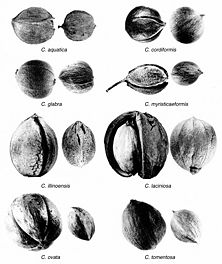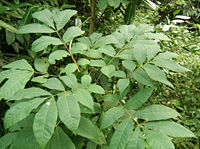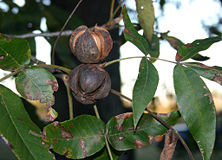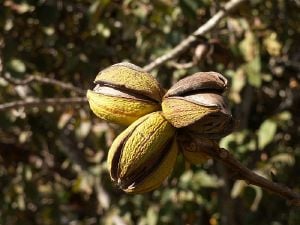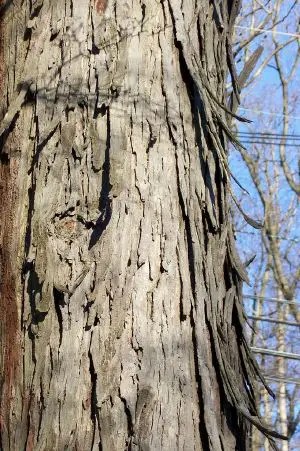Difference between revisions of "Hickory" - New World Encyclopedia
Rick Swarts (talk | contribs) |
Rick Swarts (talk | contribs) |
||
| Line 14: | Line 14: | ||
| subdivision = See text | | subdivision = See text | ||
}} | }} | ||
| − | '''Hickory''' is the common name for any of the [[deciduous]] [[tree]]s comprising the genus '''Carya''' of the Juglandaceae family, characterized by pinnately compound [[leaf|leaves]], [[flower]]s in the form of small catkins, and [[fruit]] in the form | + | '''Hickory''' is the common name for any of the [[deciduous]] [[tree]]s comprising the [[genus]] '''Carya''' of the Juglandaceae family, characterized by pinnately compound [[leaf|leaves]], [[flower]]s in the form of small catkins, and [[fruit]]s in the form of large, hard-shelled [[nut (fruit)|nuts]], with edible seeds, enclosed in a fleshy, four-valved husk that splits open at maturity. |
| Line 22: | Line 22: | ||
==Overview and description== | ==Overview and description== | ||
[[Image:Carya nuts.jpg|right|thumb|222px|Comparison of North American ''Carya'' nuts]] | [[Image:Carya nuts.jpg|right|thumb|222px|Comparison of North American ''Carya'' nuts]] | ||
| − | Hickories (genus ''Carya'') are members of the [[walnut]] family, '''Juglandaceae'''. Members of Juglandaceae have large aromatic [[leaf|leaves]], which are usually alternate, but opposite in members of ''Alfaroa'' and ''Oreomunnia''. The [[leaf|leaves]] are pinnately compound, or ternate, and usually 20 | + | Hickories (genus ''Carya'') are members of the [[walnut]] family, '''Juglandaceae'''. Members of Juglandaceae have large aromatic [[leaf|leaves]], which are usually alternate, but opposite in members of ''Alfaroa'' and ''Oreomunnia''. The [[leaf|leaves]] are pinnately compound, or ternate, and usually 20 to 100 centimeters long. The trees are wind-pollinated, the flowers usually arranged in [[catkin]]s, and the [[fruit]] is a true botanical [[nut (fruit)|nut]]. |
| − | There are eight genera in the family, including the commercially important [[nut (fruit)|nut]]-producing trees [[walnut]] (''Juglans'') and hickory (''Carya''), the later | + | There are eight [[genus|genera]] in the family, including the commercially important [[nut (fruit)|nut]]-producing trees [[walnut]] (''Juglans'') and hickory (''Carya''), the later including the commercially important [[pecan]] (''Carya illinoinensis''). The Persian walnut, ''[[Juglans regia]]'', is one of the major nut crops of the world. Walnut and hickory are also valuable timber trees. |
| − | The [[genus]] '''Carya''' (from [[Ancient Greek]] κάρυον "[[nut]]") includes 17 to 19 [[species]] of [[deciduous]] trees with pinnately compound | + | The [[genus]] '''Carya''' (from [[Ancient Greek]] κάρυον "[[nut]]") includes 17 to 19 [[species]] of [[deciduous]] trees with pinnately compound leaves and large nuts. A dozen or so species are native to [[North America]] (11–12 in the [[United States]], 1 in [[Mexico]]), and 5–6 species from [[China]] and [[Indochina]]. Another Asian species, beaked hickory, previously listed as ''Carya sinensis'', is now treated in a separate genus ''[[Annamocarya]]'', as ''Annamocarya sinensis''. |
Hickory [[flower]]s are small yellow-green [[catkin]]s produced in spring. The flowers are [[pollination|wind-pollinated]], and [[plant sexuality|monoecious]], with [[stamen|staminate]] and [[carpel|pistillate]] catkins on the same tree. | Hickory [[flower]]s are small yellow-green [[catkin]]s produced in spring. The flowers are [[pollination|wind-pollinated]], and [[plant sexuality|monoecious]], with [[stamen|staminate]] and [[carpel|pistillate]] catkins on the same tree. | ||
| − | + | As characteristic of the plant family, the hickory fruit is a true [[nut (fruit)|nut]] in the botanical sense. That is, it is a simple dry fruit with one seed in which the ovary wall becomes very hard (stony or woody) at maturity, and where the seed remains unattached or unfused with the ovary wall. The fruit is a globose or oval nut, 2 to 6 centimeters long and 1.5 to 3 centimeters in diameter, enclosed in a four-valved that splits open at maturity. The nut shell is thick and bony in most species and thin in a few species, including ''C. illinoinensis'' (pecan); it splits apart when the seed germinates. | |
==Species and classification== | ==Species and classification== | ||
| Line 68: | Line 68: | ||
[[Image:pecan-nuts-on-tree.jpg|thumb|right|Ripe pecan nuts on tree]] | [[Image:pecan-nuts-on-tree.jpg|thumb|right|Ripe pecan nuts on tree]] | ||
| − | '''Pecan'''. Pecan is the common name for a large, [[North America]]n deciduous hickory tree, ''Carya illinoinensis'', characterized by deeply furrowed bark and an edible | + | '''Pecan'''. Pecan is the common name for a large, [[North America]]n deciduous hickory tree, ''Carya illinoinensis'', characterized by deeply furrowed bark and an edible [[nut (fruit)|nut]]. The pecan grows to 20 to 40 meters in height, with a trunk up to 2 meters in diameter. The leaves are alternate, 40 to 70 centimeters long, and [[pinnate]] with 9 to 17 leaflets, each leaflet 1 to 2 centimeters long and 2 to 7 centimeters broad. The male catkins are pendulous, up to 18 centimeters long; the female catkins are small, with three to six flowers clustered together. The pecan [[fruit]] is an oval to oblong nut, 2.6 to 6 centimeters long and 1.5 to 3 centimeters broad, dark brown with a rough husk 3 to 4 millimeters thick, which splits off in four sections at maturity to release the thin-shelled nut (FNA; OBS; Collingwood et al. 1964). It is native to south-central [[North America]], including in the [[United States]] and in [[Mexico]]. |
[[Image:Hickory.bark.jpg||thumb|right|Typical bark of shagbark hickory]] | [[Image:Hickory.bark.jpg||thumb|right|Typical bark of shagbark hickory]] | ||
| − | '''Shagbark hickory'''. The shagbark hickory (''Carya ovata'') is a common hickory in the [[Eastern United States|eastern United States]] and southeast [[Canada]]. It is a large [[deciduous]] [[tree]], growing up to 27 meters tall, and will live up to 200 years old. Mature | + | '''Shagbark hickory'''. The shagbark hickory (''Carya ovata'') is a common hickory in the [[Eastern United States|eastern United States]] and southeast [[Canada]]. It is a large [[deciduous]] [[tree]], growing up to 27 meters tall, and will live up to 200 years old. Mature shagbarks are easy to recognize because, as their name implies, they have shaggy bark. This character is however only found on mature trees; young specimens have smooth bark. The [[leaf|leaves]] are 30-60 cm long, pinnate, with five (rarely three or seven) leaflets, the terminal three leaflets much larger than the basal pair. The [[flower]]s are small wind-pollinated [[catkin]]s, produced in spring. The fruit is an edible nut, 2.5 to 4 centimeters long with a green four-valved cover, which splits off at maturity in the fall, and a hard, bony shell. |
| − | The [[leaf|leaves]] are 30-60 cm long, pinnate, with five (rarely three or seven) leaflets, the terminal three leaflets much larger than the basal pair. The [[flower]]s are small wind-pollinated [[catkin]]s, produced in spring. The | ||
==Importance== | ==Importance== | ||
| − | |||
===Ecological importance=== | ===Ecological importance=== | ||
| − | The nuts of hickory trees provide an important [[food]] resource for many [[animal]]s, including [[bird]]s, [[squirrel]]s, [[deer]], [[raccoon]]s, and [[rat]]s. Many of these animals also serve as dispersal agents for the trees, spreading the nuts so that their seeds can germinate some distant from the parent tree. [[Blue jay]]s are the major avian dispersal agent for pecans, while the eastern fox squirrel is the major [[mammal]]ian dispersal agent for pecans (Sparks 2005). | + | The nuts of hickory trees, being high in [[protein]]s and [[fat]]s, provide an important [[food]] resource for many [[animal]]s, including [[bird]]s, [[squirrel]]s, [[deer]], [[raccoon]]s, and [[rat]]s. Many of these animals also serve as dispersal agents for the trees, spreading the nuts so that their seeds can germinate some distant from the parent tree. [[Blue jay]]s are the major avian dispersal agent for pecans, while the eastern fox squirrel is the major [[mammal]]ian dispersal agent for pecans (Sparks 2005). |
The hickory plants themselves are used as a food plant by the [[larva]]e of various insects, including such [[Lepidoptera]] species as: | The hickory plants themselves are used as a food plant by the [[larva]]e of various insects, including such [[Lepidoptera]] species as: | ||
| Line 99: | Line 97: | ||
===Commercial wood use=== | ===Commercial wood use=== | ||
| − | Hickory [[wood]] is extremely tough, yet flexible, and is valued for [[tool]] handles, [[bow (weapon)|bows]] (like [[taxus|yew]]), [[wheel]] spokes, [[cart]]s, [[drumstick]]s, [[lacrosse]] stick handles, [[golf club (equipment)|golf club]] shafts (sometimes still called ''hickory stick'', even though made of steel or graphite), the bottom of skis, walking canes, and so forth. They also have traditional use for punitive purposes as a [[switch (rod)|switch]] or [[switch (rod)]] (like [[hazel]]), and especially as a cane-like [[caning#types and synonyms|hickory stick]] in schools. [[Baseball]] bats were formerly made of hickory but are now more commonly made of [[ash tree|ash]]. Hickory is sometimes used for hardwood flooring due to its durability and character. | + | Hickory [[wood]] is extremely tough, yet flexible and shock resistant, and is valued for [[tool]] handles, [[bow (weapon)|bows]] (like [[taxus|yew]]), [[wheel]] spokes, [[cart]]s, [[drumstick]]s, [[lacrosse]] stick handles, [[golf club (equipment)|golf club]] shafts (sometimes still called ''hickory stick'', even though made of steel or graphite), the bottom of skis, walking canes, and so forth. They also have traditional use for punitive purposes as a [[switch (rod)|switch]] or [[switch (rod)]] (like [[hazel]]), and especially as a cane-like [[caning#types and synonyms|hickory stick]] in schools. [[Baseball]] bats were formerly made of hickory but are now more commonly made of [[ash tree|ash]]. Hickory is sometimes used for hardwood flooring due to its durability and character. |
Hickory is also highly prized for [[wood-burning stove]]s, because of its high caloric content. Hickory wood is also a preferred type for smoke curing meats. In the Southern United States, hickory is popular for cooking [[barbecue]], as hickory grows abundantly in the region, and adds flavor to the meat. | Hickory is also highly prized for [[wood-burning stove]]s, because of its high caloric content. Hickory wood is also a preferred type for smoke curing meats. In the Southern United States, hickory is popular for cooking [[barbecue]], as hickory grows abundantly in the region, and adds flavor to the meat. | ||
| Line 117: | Line 115: | ||
==External links== | ==External links== | ||
| − | *[http://www.cirrusimage.com/hickory.htm ''Carya''] Large-format diagnostic photos, [[Morton Arboretum]] acc. 29-U-10 | + | *[http://www.cirrusimage.com/hickory.htm ''Carya''] Large-format diagnostic photos, [[Morton Arboretum]] acc. 29-U-10. Retrieved June 3, 2008. |
| − | + | *[http://www.efloras.org/florataxon.aspx?flora_id=2&taxon_id=105766 Flora of China: ''Carya'']. Retrieved June 3, 2008. | |
| − | *[http://www.efloras.org/florataxon.aspx?flora_id=2&taxon_id=105766 Flora of China: ''Carya''] | + | *[http://extension-horticulture.tamu.edu/carya/species/index.htm USDA Agricultural Research Service: ''Carya'']. Retrieved June 3, 2008. |
| − | *[http://extension-horticulture.tamu.edu/carya/species/index.htm USDA Agricultural Research Service: ''Carya''] | + | *[http://www.cas.vanderbilt.edu/bioimages/pages/compare-hickories.htm Comparison of eastern North American hickories at bioimages.vanderbilt.edu]. Retrieved June 3, 2008. |
| − | + | *[http://www.cas.vanderbilt.edu/bioimages/pages/carya-fruits.htm Comparison of hickory nuts at bioimages.vanderbilt.edu]. Retrieved June 3, 2008. | |
| − | *[http://www.cas.vanderbilt.edu/bioimages/pages/compare-hickories.htm Comparison of eastern North American hickories at bioimages.vanderbilt.edu] | ||
| − | *[http://www.cas.vanderbilt.edu/bioimages/pages/carya-fruits.htm Comparison of hickory nuts at bioimages.vanderbilt.edu] | ||
[[Category:Life sciences]] | [[Category:Life sciences]] | ||
Revision as of 18:01, 3 June 2008
| Hickory | ||||||||||||
|---|---|---|---|---|---|---|---|---|---|---|---|---|
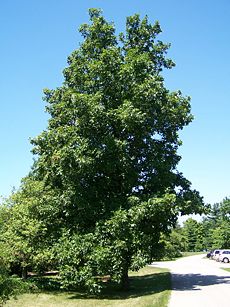 Hickory at Morton Arboretum
Accession 29-U-10 | ||||||||||||
| Scientific classification | ||||||||||||
| ||||||||||||
|
See text |
Hickory is the common name for any of the deciduous trees comprising the genus Carya of the Juglandaceae family, characterized by pinnately compound leaves, flowers in the form of small catkins, and fruits in the form of large, hard-shelled nuts, with edible seeds, enclosed in a fleshy, four-valved husk that splits open at maturity.
pecan,
shagbark hickory
Overview and description
Hickories (genus Carya) are members of the walnut family, Juglandaceae. Members of Juglandaceae have large aromatic leaves, which are usually alternate, but opposite in members of Alfaroa and Oreomunnia. The leaves are pinnately compound, or ternate, and usually 20 to 100 centimeters long. The trees are wind-pollinated, the flowers usually arranged in catkins, and the fruit is a true botanical nut.
There are eight genera in the family, including the commercially important nut-producing trees walnut (Juglans) and hickory (Carya), the later including the commercially important pecan (Carya illinoinensis). The Persian walnut, Juglans regia, is one of the major nut crops of the world. Walnut and hickory are also valuable timber trees.
The genus Carya (from Ancient Greek κάρυον "nut") includes 17 to 19 species of deciduous trees with pinnately compound leaves and large nuts. A dozen or so species are native to North America (11–12 in the United States, 1 in Mexico), and 5–6 species from China and Indochina. Another Asian species, beaked hickory, previously listed as Carya sinensis, is now treated in a separate genus Annamocarya, as Annamocarya sinensis.
Hickory flowers are small yellow-green catkins produced in spring. The flowers are wind-pollinated, and monoecious, with staminate and pistillate catkins on the same tree.
As characteristic of the plant family, the hickory fruit is a true nut in the botanical sense. That is, it is a simple dry fruit with one seed in which the ovary wall becomes very hard (stony or woody) at maturity, and where the seed remains unattached or unfused with the ovary wall. The fruit is a globose or oval nut, 2 to 6 centimeters long and 1.5 to 3 centimeters in diameter, enclosed in a four-valved that splits open at maturity. The nut shell is thick and bony in most species and thin in a few species, including C. illinoinensis (pecan); it splits apart when the seed germinates.
Species and classification
In the APG system, genus Carya (and the whole Juglandaceae family) has been recently moved to the Fagales order.
- North America
- Carya sect. Carya — typical hickories
- Carya floridana Scrub Hickory
- Carya glabra Pignut Hickory
- Carya myristiciformis Nutmeg Hickory
- Carya ovalis Red Hickory (treated as a synonym of C. glabra by Flora N. Amer.)
- Carya ovata Shagbark Hickory
- Carya ovata var. australis (syn. C. carolinae-septentrionalis) Southern Shagbark Hickory
- Carya laciniosa Shellbark Hickory
- Carya pallida Sand Hickory
- Carya texana Black Hickory
- Carya tomentosa (syn. C. alba) Mockernut Hickory
- Carya sect. Apocarya — pecans
- Carya aquatica Water Hickory
- Carya cordiformis Bitternut Hickory
- Carya illinoinensis Pecan
- Carya palmeri Mexican Hickory
- Asia
- Carya sect. Sinocarya — asian hickories
- Carya dabieshanensis Dabie Shan Hickory (may be synonymous with C. cathayensis)
- Carya cathayensis Chinese Hickory
- Carya hunanensis Hunan Hickory
- Carya kweichowensis Guizhou Hickory
- Carya poilanei Poilane's Hickory
- Carya tonkinensis Vietnamese Hickory
Two of the most important commercial species are the pecan and the shagbark hickory.
Pecan. Pecan is the common name for a large, North American deciduous hickory tree, Carya illinoinensis, characterized by deeply furrowed bark and an edible nut. The pecan grows to 20 to 40 meters in height, with a trunk up to 2 meters in diameter. The leaves are alternate, 40 to 70 centimeters long, and pinnate with 9 to 17 leaflets, each leaflet 1 to 2 centimeters long and 2 to 7 centimeters broad. The male catkins are pendulous, up to 18 centimeters long; the female catkins are small, with three to six flowers clustered together. The pecan fruit is an oval to oblong nut, 2.6 to 6 centimeters long and 1.5 to 3 centimeters broad, dark brown with a rough husk 3 to 4 millimeters thick, which splits off in four sections at maturity to release the thin-shelled nut (FNA; OBS; Collingwood et al. 1964). It is native to south-central North America, including in the United States and in Mexico.
Shagbark hickory. The shagbark hickory (Carya ovata) is a common hickory in the eastern United States and southeast Canada. It is a large deciduous tree, growing up to 27 meters tall, and will live up to 200 years old. Mature shagbarks are easy to recognize because, as their name implies, they have shaggy bark. This character is however only found on mature trees; young specimens have smooth bark. The leaves are 30-60 cm long, pinnate, with five (rarely three or seven) leaflets, the terminal three leaflets much larger than the basal pair. The flowers are small wind-pollinated catkins, produced in spring. The fruit is an edible nut, 2.5 to 4 centimeters long with a green four-valved cover, which splits off at maturity in the fall, and a hard, bony shell.
Importance
Ecological importance
The nuts of hickory trees, being high in proteins and fats, provide an important food resource for many animals, including birds, squirrels, deer, raccoons, and rats. Many of these animals also serve as dispersal agents for the trees, spreading the nuts so that their seeds can germinate some distant from the parent tree. Blue jays are the major avian dispersal agent for pecans, while the eastern fox squirrel is the major mammalian dispersal agent for pecans (Sparks 2005).
The hickory plants themselves are used as a food plant by the larvae of various insects, including such Lepidoptera species as:
- Brown-tail (Euproctis chrysorrhoea)
- the Coleophora case-bearers C. laticornella and C. ostryae.
- Regal moth (Citheronia regalis), whose caterpillars are known as hickory horn-devil
- Walnut sphinx (Amorpha juglandis)
Another insect that uses the hickory tree as a food source is the hickory leaf stem gall phylloxera (Phylloxera caryaecaulis). Phylloxeridae are related to aphids and have a similarly complex life cycle. Eggs hatch in early spring and the galls quickly form around the developing insects. Phylloxera galls may damage weakened or stressed hickories, but are generally harmless. Deformed leaves and twigs can rain down from the tree in the spring as squirrels break off infected tissue and eat the galls, possibly for the protein content of the phylloxera, or possibly because the galls are fleshy and tasty to the squirrels.
Culinary value
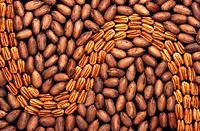
The nuts of some species of hickory are palatable, while others are bitter and only suitable for animal feed. The shagbark hickory (Carya ovata) and the shellbark hickory (Carya laciniosa]]), along with the pecan (Carya illinoinensis), are regarded by some as the finest nut trees.
The shagbark hickory nuts are edible with an excellent flavor, and are a popular food among those who know them. The trees bear too seldom for them to be grown commercially. A bark extract from shagbark hickory is also used in an edible syrup that is similar to maple syrup, with a slightly bitter, smoky taste.
Pecans also are major food item, whether eaten fresh or used in preparations of other dishes, such as pecan pie or praline candy.
When cultivated for their nuts, note that because of their self-incompatibility, clonal (grafted) trees of the same cultivar cannot pollinate each other. Two or more cultivars must be planted together for successful pollination. Seedlings (grown from hickory nuts) will usually have sufficient genetic variation.
Commercial wood use
Hickory wood is extremely tough, yet flexible and shock resistant, and is valued for tool handles, bows (like yew), wheel spokes, carts, drumsticks, lacrosse stick handles, golf club shafts (sometimes still called hickory stick, even though made of steel or graphite), the bottom of skis, walking canes, and so forth. They also have traditional use for punitive purposes as a switch or switch (rod) (like hazel), and especially as a cane-like hickory stick in schools. Baseball bats were formerly made of hickory but are now more commonly made of ash. Hickory is sometimes used for hardwood flooring due to its durability and character.
Hickory is also highly prized for wood-burning stoves, because of its high caloric content. Hickory wood is also a preferred type for smoke curing meats. In the Southern United States, hickory is popular for cooking barbecue, as hickory grows abundantly in the region, and adds flavor to the meat.
Shagbark hickory wood is used for making the bows of Native Americans..
ReferencesISBN links support NWE through referral fees
- Collingwood, G. H., W. D. Brush, and D. Butches (Eds.). 1964. Knowing Your Trees, 2nd ed. Washington, D.C.: American Forestry Association, Washington, DC.
- Flora of North America (FNA). n.d. Carya illinoinensis. Flora of North America Vol. 3. Retrieved April 13, 2008.
- Oklahoma Biological Survey (OBS). n.d. Carya illinoinensis. Oklahoma Biological Survey. Retrieved April 13, 2008.
- Sparks, D. 2005. Adaptability of pecans to its native range. HortScience 40: 1175-1189. Retrieved April 13, 2008.
- Stone, D. E. n.d. Carya Nuttall, Gen. N. Amer. Pl. 2: 220. 1818. Flora of North America Vol. 3. Retrieved June 3, 2008.
External links
- Carya Large-format diagnostic photos, Morton Arboretum acc. 29-U-10. Retrieved June 3, 2008.
- Flora of China: Carya. Retrieved June 3, 2008.
- USDA Agricultural Research Service: Carya. Retrieved June 3, 2008.
- Comparison of eastern North American hickories at bioimages.vanderbilt.edu. Retrieved June 3, 2008.
- Comparison of hickory nuts at bioimages.vanderbilt.edu. Retrieved June 3, 2008.
Credits
New World Encyclopedia writers and editors rewrote and completed the Wikipedia article in accordance with New World Encyclopedia standards. This article abides by terms of the Creative Commons CC-by-sa 3.0 License (CC-by-sa), which may be used and disseminated with proper attribution. Credit is due under the terms of this license that can reference both the New World Encyclopedia contributors and the selfless volunteer contributors of the Wikimedia Foundation. To cite this article click here for a list of acceptable citing formats.The history of earlier contributions by wikipedians is accessible to researchers here:
The history of this article since it was imported to New World Encyclopedia:
Note: Some restrictions may apply to use of individual images which are separately licensed.
